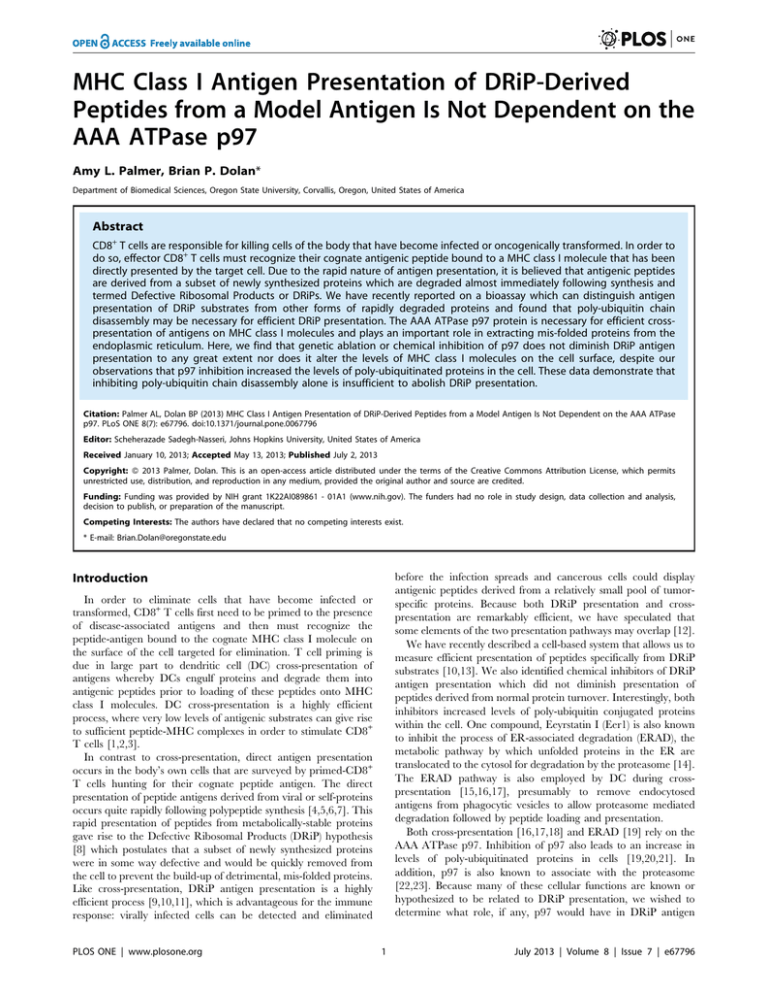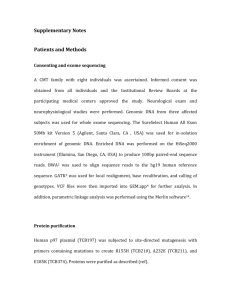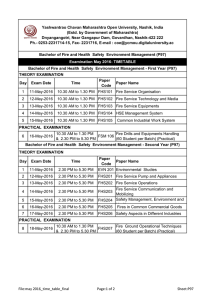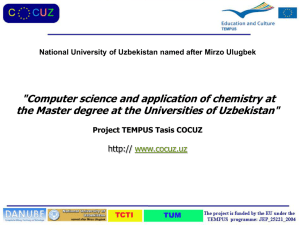MHC Class I Antigen Presentation of DRiP-Derived
advertisement

MHC Class I Antigen Presentation of DRiP-Derived
Peptides from a Model Antigen Is Not Dependent on the
AAA ATPase p97
Amy L. Palmer, Brian P. Dolan*
Department of Biomedical Sciences, Oregon State University, Corvallis, Oregon, United States of America
Abstract
CD8+ T cells are responsible for killing cells of the body that have become infected or oncogenically transformed. In order to
do so, effector CD8+ T cells must recognize their cognate antigenic peptide bound to a MHC class I molecule that has been
directly presented by the target cell. Due to the rapid nature of antigen presentation, it is believed that antigenic peptides
are derived from a subset of newly synthesized proteins which are degraded almost immediately following synthesis and
termed Defective Ribosomal Products or DRiPs. We have recently reported on a bioassay which can distinguish antigen
presentation of DRiP substrates from other forms of rapidly degraded proteins and found that poly-ubiquitin chain
disassembly may be necessary for efficient DRiP presentation. The AAA ATPase p97 protein is necessary for efficient crosspresentation of antigens on MHC class I molecules and plays an important role in extracting mis-folded proteins from the
endoplasmic reticulum. Here, we find that genetic ablation or chemical inhibition of p97 does not diminish DRiP antigen
presentation to any great extent nor does it alter the levels of MHC class I molecules on the cell surface, despite our
observations that p97 inhibition increased the levels of poly-ubiquitinated proteins in the cell. These data demonstrate that
inhibiting poly-ubiquitin chain disassembly alone is insufficient to abolish DRiP presentation.
Citation: Palmer AL, Dolan BP (2013) MHC Class I Antigen Presentation of DRiP-Derived Peptides from a Model Antigen Is Not Dependent on the AAA ATPase
p97. PLoS ONE 8(7): e67796. doi:10.1371/journal.pone.0067796
Editor: Scheherazade Sadegh-Nasseri, Johns Hopkins University, United States of America
Received January 10, 2013; Accepted May 13, 2013; Published July 2, 2013
Copyright: ß 2013 Palmer, Dolan. This is an open-access article distributed under the terms of the Creative Commons Attribution License, which permits
unrestricted use, distribution, and reproduction in any medium, provided the original author and source are credited.
Funding: Funding was provided by NIH grant 1K22AI089861 - 01A1 (www.nih.gov). The funders had no role in study design, data collection and analysis,
decision to publish, or preparation of the manuscript.
Competing Interests: The authors have declared that no competing interests exist.
* E-mail: Brian.Dolan@oregonstate.edu
before the infection spreads and cancerous cells could display
antigenic peptides derived from a relatively small pool of tumorspecific proteins. Because both DRiP presentation and crosspresentation are remarkably efficient, we have speculated that
some elements of the two presentation pathways may overlap [12].
We have recently described a cell-based system that allows us to
measure efficient presentation of peptides specifically from DRiP
substrates [10,13]. We also identified chemical inhibitors of DRiP
antigen presentation which did not diminish presentation of
peptides derived from normal protein turnover. Interestingly, both
inhibitors increased levels of poly-ubiquitin conjugated proteins
within the cell. One compound, Eeyrstatin I (Eer1) is also known
to inhibit the process of ER-associated degradation (ERAD), the
metabolic pathway by which unfolded proteins in the ER are
translocated to the cytosol for degradation by the proteasome [14].
The ERAD pathway is also employed by DC during crosspresentation [15,16,17], presumably to remove endocytosed
antigens from phagocytic vesicles to allow proteasome mediated
degradation followed by peptide loading and presentation.
Both cross-presentation [16,17,18] and ERAD [19] rely on the
AAA ATPase p97. Inhibition of p97 also leads to an increase in
levels of poly-ubiquitinated proteins in cells [19,20,21]. In
addition, p97 is also known to associate with the proteasome
[22,23]. Because many of these cellular functions are known or
hypothesized to be related to DRiP presentation, we wished to
determine what role, if any, p97 would have in DRiP antigen
Introduction
In order to eliminate cells that have become infected or
transformed, CD8+ T cells first need to be primed to the presence
of disease-associated antigens and then must recognize the
peptide-antigen bound to the cognate MHC class I molecule on
the surface of the cell targeted for elimination. T cell priming is
due in large part to dendritic cell (DC) cross-presentation of
antigens whereby DCs engulf proteins and degrade them into
antigenic peptides prior to loading of these peptides onto MHC
class I molecules. DC cross-presentation is a highly efficient
process, where very low levels of antigenic substrates can give rise
to sufficient peptide-MHC complexes in order to stimulate CD8+
T cells [1,2,3].
In contrast to cross-presentation, direct antigen presentation
occurs in the body’s own cells that are surveyed by primed-CD8+
T cells hunting for their cognate peptide antigen. The direct
presentation of peptide antigens derived from viral or self-proteins
occurs quite rapidly following polypeptide synthesis [4,5,6,7]. This
rapid presentation of peptides from metabolically-stable proteins
gave rise to the Defective Ribosomal Products (DRiP) hypothesis
[8] which postulates that a subset of newly synthesized proteins
were in some way defective and would be quickly removed from
the cell to prevent the build-up of detrimental, mis-folded proteins.
Like cross-presentation, DRiP antigen presentation is a highly
efficient process [9,10,11], which is advantageous for the immune
response: virally infected cells can be detected and eliminated
PLOS ONE | www.plosone.org
1
July 2013 | Volume 8 | Issue 7 | e67796
p97 Is Not Necessary for DRiP Presentation
antibody for 30 minutes at 4uC, washed once and resuspended in
HBSS/BSA. For total MHC class I analysis, cells were first stained
with either Y3 or W6/32 antibody, washed, and then stained with
DyLight 649-coupled goat anti-mouse IgG for 30 minutes at 4uC
followed by washing with HBSS/BSA. In some experiments cells
were stained with Y3 directly coupled to Alexa 647 for 30 minutes
on ice followed by HBSS/BSA washing. Cells were then analyzed
for expression of GFP and fluorescent antibody binding by flow
cytometry using an Accuri C6 flow cytometer (BD Biosciences).
Samples were analyzed using the BD Accuri C6 software. For
kinetic measurement’s, the mean fluorescence intensity (MFI)
levels of both GFP and Kb-SIINFEKL at time 0 hours were
treated as background and subtracted from the MFI levels at later
time points.
presentation. We find, however, that genetic and chemical
inhibition of p97 did not alter presentation of peptide antigens
from DRiP substrates, but did increase levels of poly-ubiquitinated
proteins within the cell. Though p97 does not appear to be
involved, these data demonstrate that alteration of poly-ubiquitin
profiles alone does not diminish DRiP presentation, rather specific
molecular pathways governing ubiquitin remodeling are likely to
be responsible for efficient antigen presentation.
Materials and Methods
Cell Lines and Antibodies
EL4 and EL4 cells stably expressing shield-controlled recombinant antigenic protein (here after EL4/SCRAP) have been
previously described [10] and were cultured in RMPI 1640
supplemented with 10 mM HEPES, 20 mM Glutamax, and 7.5%
fetal calf serum (all from Life Technologies) at 37uC in 6% CO2.
JY cells were a gift from Drs. Jack Bennink and Jonathan Yewdell
at National Institutes of Health [24]. Rabbit anti actin antibodies
were from Bethyl Laboratories Inc, anti-p97 monoclonal antibody
(clone 58.13.3) was from Fitzgerald Industries International, antipoly ubiquitin monoclonal antibody (clone FK2) was from Enzo,
anti-MHC class I Kb monoclonal antibody (clone Y3), anti-HLA
A,B,C (clone W6/32), and monoclonal antibody 25D-1.16 (anti
Kb-SIINFEKL) were gifts of Drs. Bennink and Yewdell (NIH).
The PE-Cy5.5 coupled anti-Thy1.1 (and corresponding isotype
control antibody) were from eBioscience, and DyLight 649coupled goat anti-mouse IgG was from from KPL. Seconday
antibodies for western blot analysis, IRDye 680LT goat antimouse and IRDye 800CW anti-rabbit polyclonal antibodies, were
from LI-COR. 25D-1.1.6 and Y3 antibodies were directly coupled
to Alexa 647 dye using a Molecular Probes protein labeling kit and
following the manufactures instructions.
Toxicity Tests
Cells were treated with varying concentrations of DBeQ or
DMSO alone and cultured for 4 hours. At that time toxic effects of
the drugs were determined using the alamarBlueTM viability assay
(Invitrogen) with a few modifications to the manufacturer’s
protocol. Briefly, cells were harvested and washed in cold Hank’s
Balanced Salt solution (HBSS, Life Technologies) supplemented
with 0.1% BSA (Amresco). Cells were incubated with alamarBlueTM for 30 minutes at 4uC and fluorescence of substrate was
measured using a Tecan Infinite 200 microplate reader.
Western Blot Analysis
Cells were harvested and resuspended to 107cells/ml in SDSSample buffer (Amresco) containing 10 nM N-Ethylmaleimide
(Alpha Aesar) and immediately boiled for 20 minutes at 95uC. An
equal volume of water supplemented with 10 mM DTT was
added to the lysate and boiled for an additional 10 minutes.
Samples were then resolved by SDS-PAGE analysis and transferred to nitrocellulose membranes (LI-COR). Membranes were
blocked with a 4% dehydrated milk solution made in Tris-buffered
saline with 0.1% Tween 20 (TBS-T) for 1 hour. Antibody
solutions in 0.5% milk/TBS-T were then added to membranes
and incubated with agitation for 1 hour at room temperature.
Membranes were washed with TBS-T for 10 minutes, then rinsed
with water and analyzed using an Odyssey infrared imaged (LICOR). Signals were quantified using the instrumental software.
Transfections
The IRES containing vector pMSCV Thy1.1 expressing wildtype or dominant negative (DN) p97 and Thy1.1 were from Dr.
Peter Cresswell (Yale) and have been previously described [17].
The ERAD substrate TCRa-GFP in pLNCX2 was from Dr.
Yihong Ye and has been previously described [25]. Transfections
were performed with an Amaxa 96-well shuttle nucleofector
(Lonza). Briefly, 56105 EL4/SCRAP cells were resuspended in
20 ml transfection solution SF to which 300 ng of DNA was added
and cells placed in one well of the cuvette plate. Cells were
transfected using program DS-113, incubated for 5 minutes at
37uC, and then plated in complete media.
Statistics
Student’s t-test analysis and linear regression calculations were
performed using GraphPad Prism software.
Results
Antigen Presentation Assays
Genetic Ablation of p97 does not Alter DRiP Antigen
Presentation
Cells were chilled on ice for 10 minutes and resuspended in icecold citric acid buffer (0.13 M citric acid and 0.0625 M dibasic
sodium phosphate, pH = 3) at 1–26107 cells/ml for 2 minutes. Ice
cold RPMI 1640 was added to wash the cells and then cells were
resuspended in warm tissue culture media at 16106 cells/ml. Cells
were cultured for indicated times in the presence of 5 mM shield-1
and harvested for flow cytometry analysis. In some experiments,
N2,N4-dibenzylquinazoline-2,4-diamine (DBeQ) was added to cells
following acid wash at the indicated concentrations. DBeQ was a
kind gift of Dr. Tsui-Fen Chou (UCLA).
We have recently described a method for distinguishing DRiP
antigen presentation from presentation of peptides derived from
substrates as the result of normal protein turnover [10,13]. The
system took advantage of the mutant form of FKBP12 which
destabilizes the protein to which it is appended, a process which
can be reversed with a small molecule termed shield-1 [26]. The
shield-controlled recombinant antigenic protein (or SCRAP)
contains the destabilization domain, followed by the mouse
MHC class I Kb-binding SIINFEKL peptide and GFP. When
EL4 cells stably expressing SCRAP were exposed to saturating
doses of shield-1, robust presentation of SIINFEKL continued
despite the biochemical evidence that all synthesized SCRAP was
spared from degradation [10]. This observation indicated a small
fraction of SCRAP DRiPs were responsible for providing peptides
Flow Cytometry
Cells were harvested and washed in cold Hank’s Balanced Salt
solution (HBSS, Life Technologies) supplemented with 0.1% BSA
(Amresco). For Kb-SIINFEKL and Thy1.1 expression, cells were
stained with Alexa-647 coupled 25D-1.16 mAb and anti Thy1.1
PLOS ONE | www.plosone.org
2
July 2013 | Volume 8 | Issue 7 | e67796
p97 Is Not Necessary for DRiP Presentation
To determine if p97 is necessary for successful antigen
presentation, it is necessary to treat EL4/SCRAP cells with cold
citric acid to remove existing peptide-MHC complexes from the
cell surface. As shown in figure 2A, acid washing removes almost
all Kb-SIINFEKL complexes from EL4/SCRAP cells as determined by staining with the Kb-SIINFEKL specific monoclonal
antibody 25D-1.16. Immediately following acid washing, 25D1.16 staining of EL4/SCRAP cells is similar to EL4 cells which do
not generate Kb-SIINFEKL complexes. Following 5 hours of
culture in the presence of shield-1, Kb-SIINFEKL levels have
recovered to approximately half the levels measured in nontreated cells (Figure 2A), in agreement with our previously
published results [10]. To determine the effect of p97 inhibition
on antigen presentation, we transfected cells with p97 expression
plasmids (or empty vector controls) and measured Kb-SIINFEKL
recovery in acid-washed transfectants in the presence of a
saturating dose (5 mM) of shield-1 for a 5 hour time period. Cells
were harvested every hour for five hours and analyzed by flow
cytometry for SCRAP synthesis and DRiP antigen presentation by
gating on Thy1.1 positive cells. DN p97 expression did not affect
either GFP accumulation in cells (figure 2B) nor did it alter the
presentation of the SIINFEKL peptide from DRiP forms of
SCRAP (figure 2C). Inhibition of p97 did not impact the recovery
of Kb-SIINFEKL complexes in the absence of shield-1 (Figure 2C),
where all expressed copies of SCRAP are subject to rapid
degradation. Therefore, genetically inhibiting the function of p97
does not alter DRiP presentation or substrate synthesis.
for presentation. Furthermore the presentation of peptides from
the shield-1 insensitive SCRAP DRiPs could be modulated by
certain chemical inhibitors which did not prevent presentation of
other forms of SCRAP.
One compound which repressed presentation of the DRiP form
(ie shield-1 insensitive) of SCRAP inhibits the AAA ATPase p97
[14,27]. To determine if p97 was necessary for DRiP antigen
presentation, we transfected EL4/SCRAP cells with vectors
containing either wild type or the dominant negative (DN) form
of p97 expressed in an IRES construct that allows simultaneous
expression of cell-surface Thy1.1 [17]. As shown in figure 1A
.50% of cells expressed Thy1.1 following transfection and
elevated levels of p97 protein were detected in western blot lysates
(figure 1B). To determine if the DN p97 was functioning in EL4
cells, we tested the ability of transfected cells to rescue expression
of mutant TCRa-GFP, encoded on a second transfected plasmid.
This construct is subject to p97-dependant ERAD and inhibition
of ERAD results in accumulation of GFP [25]. As anticipated,
expression of DN p97 led to an increase in GFP signal (p,0.05)
indicating that DN p97 expression in EL4 cells does inhibit p97dependant cellular processes.
Inhibition of p97 Leads to an Increase in Polyubiquitinated Proteins
Our previous work demonstrated that chemical inhibition of
DRiP presentation was accompanied by an increase in the level of
poly-ubiquitinated proteins in cells. A similar increase in polyubiquitinated proteins accompanies p97 ablation presumably due
to the accumulation of ubiquitinated ERAD substrates that are
unable to be degraded [19,20,21]. To determine if the DN p97
construct functioned in a similar manner in our system, we
examined total cell lysates from EL4/SCRAP cells transfected
with the empty vector, wild type p97 or the DN mutant of p97 for
levels of poly-ubiquitinated proteins. As shown in figure 3, DN
p97-expressing cells appear to have elevated levels of polyubiquitin protein conjugates which was confirmed when the polyubiquitin signal was normalized to the levels of actin in the cell
lysate (p,0.05). Therefore, expression of DN p97 does in fact
inhibit p97 functions in these cells.
Chemical Inhibition of p97 does not Alter DRiP Antigen
Presentation
A recently described compound, N2,N4-dibenzylquinazoline2,4-diamine, also known as DBeQ, was shown to inhibit p97
function in cells [28]. In EL4 cells, DBeQ exhibited single-dose
toxicity at concentrations greater than 0.5 mM (Figure 4A). To
determine if DBeQ treatment inhibited p97 function we again
assayed for rescue of the GFP-coupled ERAD substrate. EL4 cells
expressing the mutant TCRa-GFP construct had increased GFP
fluorescence when treated with 0.5 mM DBeQ (p,0.05, Figure 4B)
similar to expression of DN p97. Therefore, treating EL4 cells with
a sub-toxic dose of DBeQ can inhibit p97 function. We then tested
DBeQ to determine if it could inhibit DRiP antigen presentation.
Treatment with increasing concentrations of DBeQ showed a
minor inhibition of DRiP antigen presentation (figure 4D) and no
noticeable effect on SCRAP synthesis (figure 4C). However the
effect on antigen presentation was much more mild than
Figure 1. Transfected EL4/SCRAP cells express elevated levels
of p97 protein. A. EL4/SCRAP cells were transfected with pMSCV
containing an IRES insert that allowed for dual expression of Thy1.1 and
either wild type (black trace) or a dominant-negative mutant (blue
trace) of p97. Cells were stained with anti-Thy1.1 antibody 24 hours
post transfected and analyzed by FACS. Representative histograms are
shown with the isotype control antibody staining represented by the
shaded histogram. B. Total cell lysates from cells transfected with wild
type (WT) or dominant negative (DN) p97 vectors were prepared 24
hours after transfection and resolved by SDS-PAGE followed by western
blot analysis for p97 protein and actin. C. EL4 cells were transfected with
constructs encoding a mutated TCRa- GFP construct and either WT or
DN expression plasmids. The following day Thy1.1 cells were analyzed
for GFP expression. DN transfected cells had elevated levels of GFP
(p,0.05) indicating inhibited ERAD function.
doi:10.1371/journal.pone.0067796.g001
PLOS ONE | www.plosone.org
3
July 2013 | Volume 8 | Issue 7 | e67796
p97 Is Not Necessary for DRiP Presentation
Figure 2. Genetic ablation of p97 does not diminish DRiP antigen presentation. A. EL4/SCRAP cells were placed in ice-cold citric acid buffer
(pH 3) for 2 minutes, washed, re-suspended in tissue culture media, and cultured for 5 hours in the presence of shield-1 before staining with the
monoclonal antibody 25D-1.16 to detect Kb-SIINFEKL complexes at the cell surface. Kb-SIINFEKL complexes recovered from near background levels
(blue trace) to approximately 50% (orange trace) the level of cells that had not been washed in acid (black trace). EL4 cells that do not express KbSIINFEKL are shown as a negative control (shaded histogram) and are considered background 25D- 1.16 staining. B and C. EL4/SCRAP cells were
transfected with either an empty vector, wild type (WT) or DN p97 constructs and 24 hours later, washed in mild citric acid to elute existing peptides
from MHC class I molecules. Cells were then treated with 5 mM shield-1 and cultured for 5 hours. At indicated times cells were collected and analyzed
by FACS. Cells expressing Thy1.1 were subsequently analyzed for GFP expression (B) and the mean fluorescence intensity (MFI) plotted. Kb-SIINFEKL
expression (C) was analyzed for both DRiP substrates (left) and the rapidly degraded form of SCRAP (right) and the MFI plotted as a function of time.
doi:10.1371/journal.pone.0067796.g002
(figure 5B). In contrast a 5 hour treatment with 10 mM MG132
reduced Kb levels by almost 60–80% by inhibiting proteasome
function and preventing peptide generation (p,0.05). To confirm
this observation and to account for the toxic effect of DBeQ in
EL4 cells, we tested the effect of DBeQ treatment in a second cell
line. The human lymphoblastoid cell line JY was treated with
increasing concentrations of DBeQ without diminishing the
conversion of alamarBlue (Figure 6A). A five hour treatment with
DBeQ did not alter the expression of MHC class I on JY cells that
had been treated with citric acid or left untreated. The data is an
average of triplicate staining and the experiment was repeated
three times. No statistical difference was noted at any concentration of DBeQ treatment. Therefore p97 function is not necessary
for antigen presentation.
proteasome inhibition and did not demonstrate a clear dosedependent response. Therefore, it is unlikely that chemical
inhibition of p97 with DBeQ significantly affects DRiP antigen
presentation.
Inhibition of p97 does not Alter MHC Class I Levels
While our data thus far suggest that p97 is dispensable for DRiP
antigen presentation, this may only hold true for our specific
construct and not be generalized to other DRiP substrates. We
therefore measured total Kb on the surface of EL4 cells that were
either untreated or washed in citric acid to remove existing MHC
class I-peptide complexes expressing DN p97 or wild type p97
proteins. As shown in figure 5A, 24 hours after transfection with
p97 constructs Kb levels on the cell surface were unaltered. We
also determined the effect of a 5 hour DBeQ treatment and found
total cell-surface Kb levels appear to be slightly diminished, though
any statistical difference noted at a particular concentration was
not consistent between the three experiments that were conducted
PLOS ONE | www.plosone.org
Discussion
The AAA ATPase p97 activity has been reported for several
cellular pathways which are likely involved in DRiP antigen
4
July 2013 | Volume 8 | Issue 7 | e67796
p97 Is Not Necessary for DRiP Presentation
Figure 3. Poly-ubiquitinated proteins accumulate in cells expressing DN p97. Total cell lysates were prepared 24 hours after transfection
with empty vector, wild type p97, or DN p97 protein and analyzed by SDS-PAGE and western plot analysis. A. Blots were stained with anti-polyubiquitin monoclonal antibodies (top), anti-actin polyclonal antibodies (middle), or anti-p97 monoclonal antibodies (bottom). B. Signals of both polyubiquitin conjugated protein were normalized to actin levels in the cell and are depicted graphically. The average ratio of poly-ubiquitin signal to
actin for four experiments is plotted. DN p97 expression resulted in a statistically significant accumulation of poly-ubiquitin conjugates in cells
(p,0.05).
doi:10.1371/journal.pone.0067796.g003
ribosomes [35,36], it is highly unlikely that SCRAP, either as a
DRiP or functional protein, would ever be found in the ER. It is
therefore unlikely that the cellular processes for extraction of
endocytosed antigens would be involved in SCRAP presentation.
However, this does not explain why p97 inhibition did not
generally lower the levels of cell-surface MHC class I molecules, as
presumably some DRiPs would localize within the ER and be
subject to p97 mediated ERAD.
Data presented here also demonstrate that DRiP presentation
can continue unabated while poly-ubiquitin chain disassembly is
prevented. Previous work demonstrated that inhibitors of DRiP
presentation also increased the levels of poly-ubiquitin conjugated
proteins in the cell. We speculated that one or more deubiquitinating enzymes (or DUBs) may be responsible for DRiP
presentation. However, we did not rule out that simply altering
ubiquitin homeostasis within the cell could adversely impact
presentation of DRiP-derived peptides. In this study, like many
others, p97 inhibition also resulted in increased levels of polyubiquitin conjugated proteins. Therefore, simply altering the levels
of poly-ubiquitinated proteins in the cell (and presumably, altering
the homeostasis of ubiquitin) is not sufficient to inhibit DRiP
presentation and lends credence to the hypothesis that specific
DUBs are responsible for ensuring presentation of peptides from
DRiPs.
Recent studies have suggested that antigen presentation is
compartmentalized [13,37,38], though no work to date has
identified such a compartment. As p97 has an important role in
removing or remodeling proteins in diverse organelles including
the nucleus, mitochondria, ER, lysosomes, autophagosomes, golgi
and probably more, our findings would suggest the antigen
presentation compartment may not have a higher order structure
presentation. Studies have found p97 directly linked to the
proteasome [22,23], and is an essential player in the degradation
of mis-folded proteins, particularly those associated within
membrane-bound organelles such as the ER and autophagosomes
[29,30,31]. Successful cross-presentation of antigens on MHC
class I molecules also requires functional p97 [16,17,18].
Additionally, a known chemical inhibitor of DRiP presentation
targets p97 [27]. The circumstantial evidence certainly pointed to
p97 playing an important role in DRiP presentation, however the
data reported here suggest this is not the case. Both genetic
ablation and chemical inhibition of p97 did not impact DRiP
presentation from a model substrate and did not have an overall
impact on the levels of cell-surface MHC class I.
DRiP antigen presentation is an efficient process, which allows
cells of the body to ensure that peptides are presented from
relatively few substrates assuring successful immune surveillance of
rare transcripts. Likewise, the cross-presentation of peptides from
engulfed antigens is also highly efficient: peptide-MHC complexes
can be generated in sufficient quantities to stimulate CD8+ T cells
from a relatively small input of substrates. Because of the high
efficiency in both DRiP presentation and cross-presentation,
overlap between the two processes is likely to occur [12].
However, the cellular locations of the two processes are sufficiently
different that overlap may be more rare than previously
hypothesized. Cross-presentation first requires antigenic protein
to be endocytosed into the cell prior to degradation either in the
cytosol or endosomal compartments [32,33,34]. DRiPs form as the
result of protein synthesis, a process that occurs on ribosomes
located in the cytosol or on the cytosolic face of the ER. SCRAP
does not contain an ER-targeting sequence, and while such a
sequence is not a prerequisite for synthesis on ER-bound
PLOS ONE | www.plosone.org
5
July 2013 | Volume 8 | Issue 7 | e67796
p97 Is Not Necessary for DRiP Presentation
Figure 4. DBeQ treatment fails to inhibit DRiP antigen presentation. A. Cells were tested for metabolic turnover of alamarBlue four hours
post DBeQ treatment as a proxy for toxicity. Concentrations of DBeQ .1 mM showed single-dose toxic effects. B. DBeQ treatment resulted in
accumulation of mutant TCRa-GFP at non-toxic doses of DBeQ (* p,0.05). Acid-washed EL4/SCRAP cells were treated with 5 mM shield-1 and
increasing amounts of the p97-inhibiting compound DBeQ or 10 mM MG132. At indicated times, cells were analyzed for either GFP expression (C) and
Kb-SIINFEKL accumulation (D).
doi:10.1371/journal.pone.0067796.g004
similar to an organelle. It is possible that such a compartment is
rather a microdomain in the cell where all the necessary molecules
come into contact to perform the function of antigen presentation.
If so, further examination of molecular pathways that govern
DRiP presentation should shed light on how a subset of newly
synthesized proteins can be degraded and loaded onto MHC class
I molecules in a highly efficient manner.
Figure 5. Inhibition of p97 does not diminish over all levels of cell-surface MHC class I. A. EL4 cells were transfected with p97 constructs
and analyzed 24 hours later for cell-surface Kb expression by FACS by gating onThy1.1 cells. Cells were either left untreated (white bars) or washed in
citric acid buffer (black bars) and allowed to recover for five hours before analysis. The staining was done in triplicate. B. EL4 cells were treated with
indicated levels of DBeQ for 5 hours and analyzed by FACS for cell-surface Kb expression. No consistent statistical difference at any concentration of
DBeQ occurred between experiments, though MG132 did statistically diminish Kb levels (p,0.05). In both experiments, EL4 cells treated with 10 mM
MG132 for 5 hours was included as a positive control for inhibiting antigen presentation and diminishing cell-surface Kb.
doi:10.1371/journal.pone.0067796.g005
PLOS ONE | www.plosone.org
6
July 2013 | Volume 8 | Issue 7 | e67796
p97 Is Not Necessary for DRiP Presentation
Figure 6. DBeQ treatment of JY cells does not diminish HLA class I levels. A. AlamarBlue fluorescence of JY cells treated with either DMSO or
increasing doses of DBeQ demonstrates JY cells are more resistant to the single-dose toxic effects of DBeQ. B. JY cells were either washed in citric acid
buffer (black bars) or left untreated (white bars) and stained, in triplicate, 5 hours post treatment with indicated concentrations of DBeQ or MG132.
Cells were analyzed for total MHC class I expression using the monoclonal antibody W6/32 which detects HLA A,B, and C molecules. This experiment
is representative of three independent experiments and no statistical difference between DMSO and DBeQ treated cells was noted.
doi:10.1371/journal.pone.0067796.g006
Acknowledgments
Author Contributions
We wish to thank Dr. Peter Cresswell (Yale University) for the p97 DNA
vectors and Dr. Dr. Tsui-Fen Chou (UCLA) for DBeQ. The mutant
TCRa-GFP fusion construct was a gift from Dr. Yihong Ye (NIH). Cell
lines described here were a gift of Drs. Jack Bennink and Jonathan Yewdell
(NIH).
Conceived and designed the experiments: ALP BPD. Performed the
experiments: ALP BPD. Analyzed the data: ALP BPD. Wrote the paper:
ALP BPD.
References
1. Li M, Davey GM, Sutherland RM, Kurts C, Lew AM, et al. (2001) Cellassociated ovalbumin is cross-presented much more efficiently than soluble
ovalbumin in vivo. Journal of Immunology 166: 6099–6103.
2. Larsson M, Fonteneau JF, Somersan S, Sanders C, Bickham K, et al. (2001)
Efficiency of cross presentation of vaccinia virus-derived antigens by human
dendritic cells. Eur J Immunol 31: 3432–3442.
3. Schnorrer P, Behrens GMN, Wilson NS, Pooley JL, Smith CM, et al. (2006) The
dominant role of CD8+ dendritic cells in cross-presentation is not dictated by
antigen capture. Proceedings of the National Academy of Sciences 103: 10729–
10734.
4. Esquivel F, Yewdell J, Bennink J (1992) RMA/S cells present endogenously
synthesized cytosolic proteins to class I-restricted cytotoxic T lymphocytes. J Exp
Med 175: 163–168.
5. Khan S, de Giuli R, Schmidtke G, Bruns M, Buchmeier M, et al. (2001) Cutting
edge: neosynthesis is required for the presentation of a T cell epitope from a
long-lived viral protein. J Immunol 167: 4801–4804.
6. Cardinaud S, Starck SR, Chandra P, Shastri N (2010) The synthesis of truncated
polypeptides for immune surveillance and viral evasion. PLoS One 5: e8692.
7. Mackay LK, Long HM, Brooks JM, Taylor GS, Leung CS, et al. (2009) T cell
detection of a B-cell tropic virus infection: newly-synthesised versus mature viral
proteins as antigen sources for CD4 and CD8 epitope display. PLoS Pathog 5:
e1000699.
8. Yewdell JW, Anton LC, Bennink JR (1996) Defective ribosomal products
(DRiPs): a major source of antigenic peptides for MHC class I molecules?
J Immunol 157: 1823–1826.
9. Dolan BP, Li L, Takeda K, Bennink JR, Yewdell JW (2010) Defective ribosomal
products are the major source of antigenic peptides endogenously generated
from influenza A virus neuraminidase. J Immunol 184: 1419–1424.
10. Dolan BP, Li L, Veltri CA, Ireland CM, Bennink JR, et al. (2011) Distinct
pathways generate peptides from defective ribosomal products for CD8+ T cell
immunosurveillance. J Immunol 186: 2065–2072.
11. Princiotta MF, Finzi D, Qian SB, Gibbs J, Schuchmann S, et al. (2003)
Quantitating protein synthesis, degradation, and endogenous antigen processing.
Immunity 18: 343–354.
12. Dolan BP, Bennink JR, Yewdell JW (2011) Translating DRiPs: progress in
understanding viral and cellular sources of MHC class I peptide ligands. Cell
Mol Life Sci 68: 1481–1489.
13. Lu X, Gibbs JS, Hickman HD, David A, Dolan BP, et al. (2012) Endogenous
viral antigen processing generates peptide-specific MHC class I cell-surface
clusters. Proc Natl Acad Sci U S A 109: 15407–15412.
14. Wang Q, Li L, Ye Y (2008) Inhibition of p97-dependent protein degradation by
Eeyarestatin I. J Biol Chem 283: 7445–7454.
15. Imai J, Hasegawa H, Maruya M, Koyasu S, Yahara I (2005) Exogenous antigens
are processed through the endoplasmic reticulum-associated degradation
PLOS ONE | www.plosone.org
16.
17.
18.
19.
20.
21.
22.
23.
24.
25.
26.
27.
28.
29.
7
(ERAD) in cross-presentation by dendritic cells. International Immunology 17:
45–53.
Ackerman AL, Giodini A, Cresswell P (2006) A Role for the Endoplasmic
Reticulum Protein Retrotranslocation Machinery during Crosspresentation by
Dendritic Cells. Immunity 25: 607–617.
Giodini A, Rahner C, Cresswell P (2009) Receptor-mediated phagocytosis elicits
cross-presentation in nonprofessional antigen-presenting cells. Proceedings of the
National Academy of Sciences 106: 3324–3329.
Zehner M, Chasan AI, Schuette V, Embgenbroich M, Quast T, et al. (2011)
Mannose receptor polyubiquitination regulates endosomal recruitment of p97
and cytosolic antigen translocation for cross-presentation. Proceedings of the
National Academy of Sciences 108: 9933–9938.
Ye Y, Meyer HH, Rapoport TA (2001) The AAA ATPase Cdc48/p97 and its
partners transport proteins from the ER into the cytosol. Nature 414: 652–656.
Wojcik C, Yano M, DeMartino GN (2004) RNA interference of valosincontaining protein (VCP/p97) reveals multiple cellular roles linked to ubiquitin/
proteasome-dependent proteolysis. J Cell Sci 117: 281–292.
Dalal S, Rosser MF, Cyr DM, Hanson PI (2004) Distinct roles for the AAA
ATPases NSF and p97 in the secretory pathway. Mol Biol Cell 15: 637–648.
Isakov E, Stanhill A (2011) Stalled proteasomes are directly relieved by P97
recruitment. J Biol Chem 286: 30274–30283.
Besche HC, Haas W, Gygi SP, Goldberg AL (2009) Isolation of Mammalian 26S
Proteasomes and p97/VCP Complexes Using the Ubiquitin-like Domain from
HHR23B Reveals Novel Proteasome-Associated Proteins{. Biochemistry 48:
2538–2549.
Korman AJ, Ploegh HL, Kaufman JF, Owen MJ, Strominger JL (1980) Cell-free
synthesis and processing of the heavy and light chains of HLA-DR antigens.
J Exp Med 152: 65s-82s.
Soetandyo N, Wang Q, Ye Y, Li L (2010) Role of intramembrane charged
residues in the quality control of unassembled T-cell receptor a-chains at the
endoplasmic reticulum. J Cell Sci 123: 1031–1038.
Banaszynski LA, Chen L-c, Maynard-Smith LA, Ooi AGL, Wandless TJ (2006)
A Rapid, Reversible, and Tunable Method to Regulate Protein Function in
Living Cells Using Synthetic Small Molecules. Cell 126: 995–1004.
Wang Q, Shinkre BA, Lee J-g, Weniger MA, Liu Y, et al. (2010) The ERAD
Inhibitor Eeyarestatin I Is a Bifunctional Compound with a Membrane-Binding
Domain and a p97/VCP Inhibitory Group. PLoS One 5: e15479.
Chou T-F, Brown SJ, Minond D, Nordin BE, Li K, et al. (2011) Reversible
inhibitor of p97, DBeQ, impairs both ubiquitin-dependent and autophagic
protein clearance pathways. Proceedings of the National Academy of Sciences
108: 4834–4839.
Yamanaka K, Sasagawa Y, Ogura T (2012) Recent advances in p97/VCP/
Cdc48 cellular functions. Biochimica et Biophysica Acta (BBA) - Molecular Cell
Research 1823: 130–137.
July 2013 | Volume 8 | Issue 7 | e67796
p97 Is Not Necessary for DRiP Presentation
30. Meyer H, Bug M, Bremer S (2012) Emerging functions of the VCP/p97 AAAATPase in the ubiquitin system. Nat Cell Biol 14: 117–123.
31. Bug M, Meyer H (2012) Expanding into new markets – VCP/p97 in endocytosis
and autophagy. Journal of Structural Biology 179: 78–82.
32. Burgdorf S, Kurts C (2008) Endocytosis mechanisms and the cell biology of
antigen presentation. Current Opinion in Immunology 20: 89–95.
33. Groothuis TAM, Neefjes J (2005) The many roads to cross-presentation. J Exp
Med 202: 1313–1318.
34. Jutras I, Desjardins M (2005) PHAGOCYTOSIS: At the Crossroads of Innate
and Adaptive Immunity. Annual Review of Cell and Developmental Biology 21:
511–527.
35. Reid DW, Nicchitta CV (2012) Primary role for endoplasmic reticulum-bound
ribosomes in cellular translation identified by ribosome profiling. J Biol Chem
287: 5518–5527.
PLOS ONE | www.plosone.org
36. Stephens SB, Nicchitta CV (2008) Divergent regulation of protein synthesis in
the cytosol and endoplasmic reticulum compartments of mammalian cells. Mol
Biol Cell 19: 623–632.
37. Dolan BP, Knowlton JJ, David A, Bennink JR, Yewdell JW (2010) RNA
polymerase II inhibitors dissociate antigenic peptide generation from normal
viral protein synthesis: a role for nuclear translation in defective ribosomal
product synthesis? J Immunol 185: 6728–6733.
38. Lev A, Princiotta MF, Zanker D, Takeda K, Gibbs JS, et al. (2010)
Compartmentalized MHC class I antigen processing enhances immunosurveillance by circumventing the law of mass action. Proc Natl Acad Sci U S A 107:
6964–6969.
8
July 2013 | Volume 8 | Issue 7 | e67796








